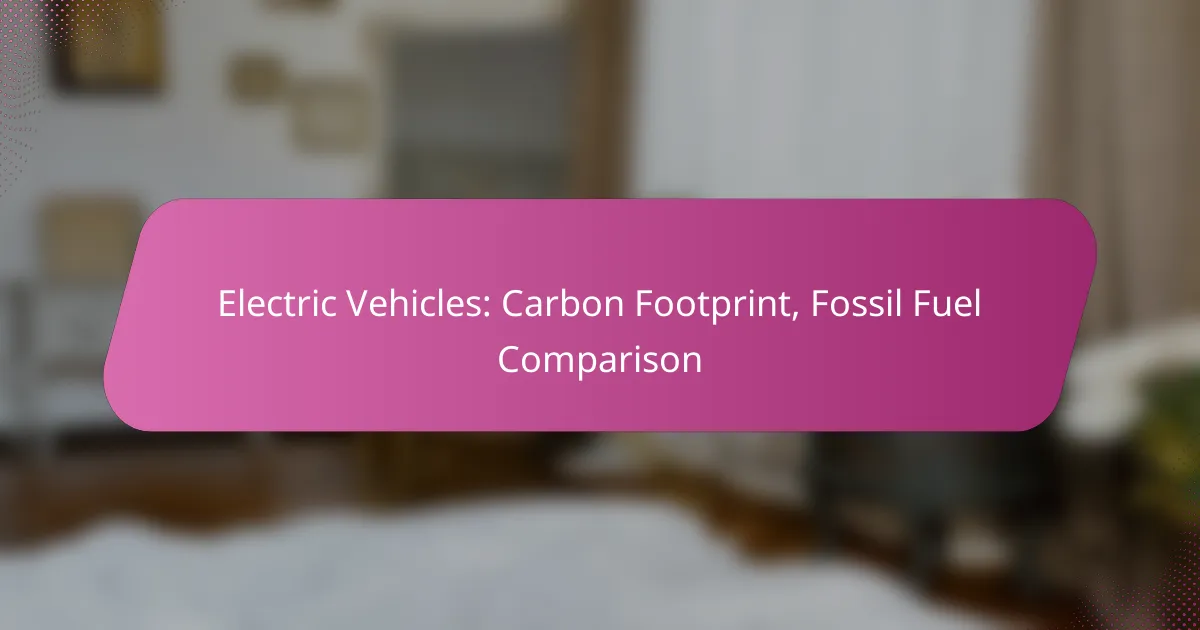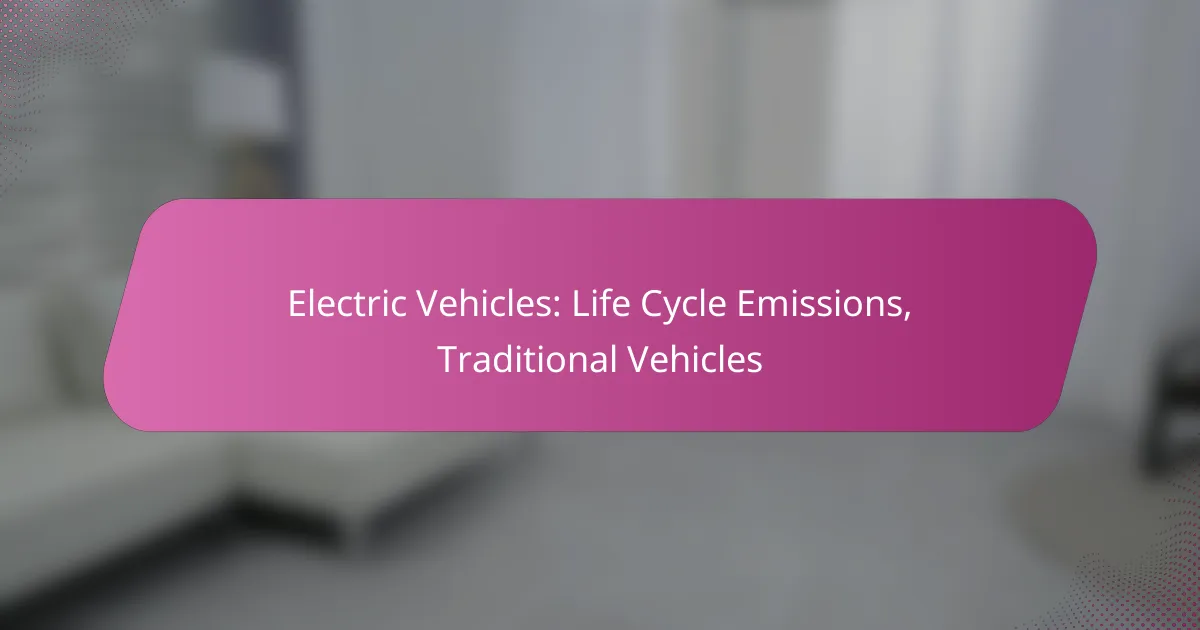Electric vehicles (EVs) play a crucial role in reducing carbon footprints by generating zero tailpipe emissions and leveraging cleaner energy sources. While their overall environmental impact can vary based on the electricity used for charging and manufacturing processes, EVs typically have a lower carbon footprint compared to traditional fossil fuel vehicles, particularly when powered by renewable energy.
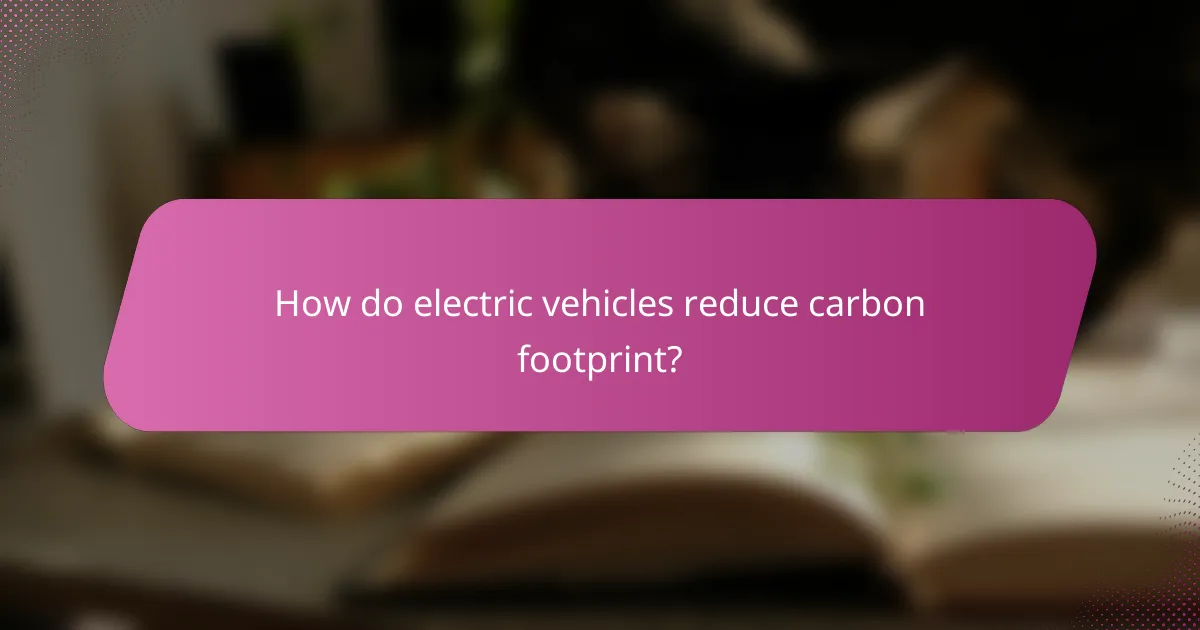
How do electric vehicles reduce carbon footprint?
Electric vehicles (EVs) significantly reduce carbon footprints by producing zero tailpipe emissions and utilizing cleaner energy sources. Their overall impact on greenhouse gas emissions is lower compared to traditional fossil fuel vehicles, especially when charged with renewable energy.
Lower emissions during operation
Electric vehicles generate no direct emissions while driving, which is a major advantage over gasoline or diesel cars. This operational efficiency can lead to reductions in greenhouse gas emissions by as much as 50% or more, depending on the energy mix used for charging.
For example, in regions where coal is the primary energy source, the emissions reduction may be less pronounced. However, as more renewable energy sources are integrated into the grid, the overall emissions from EV operation continue to decrease.
Use of renewable energy sources
Charging electric vehicles with renewable energy sources, such as solar or wind, further minimizes their carbon footprint. When EVs are powered by clean energy, their lifecycle emissions can be significantly lower than those of conventional vehicles.
Many countries are promoting the use of renewables through incentives and subsidies, making it easier for EV owners to access green energy. For instance, in the European Union, various programs encourage the installation of solar panels to charge EVs, enhancing sustainability.
Battery recycling initiatives
Battery recycling is crucial for reducing the environmental impact of electric vehicles. As the demand for EVs grows, so does the need for effective recycling programs to manage battery waste and recover valuable materials.
Many manufacturers are investing in battery recycling technologies to reclaim lithium, cobalt, and nickel, which can be reused in new batteries. This not only lessens the demand for raw materials but also minimizes the carbon footprint associated with mining and processing.
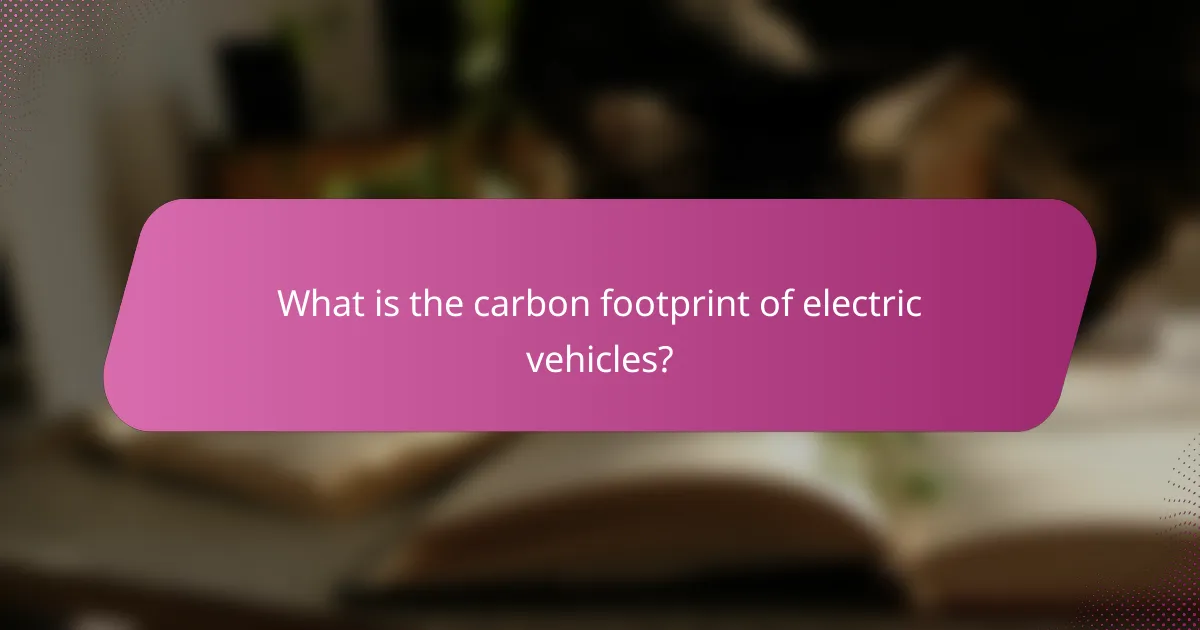
What is the carbon footprint of electric vehicles?
The carbon footprint of electric vehicles (EVs) primarily comes from the electricity used to charge them and the manufacturing processes involved. While EVs produce zero tailpipe emissions, their overall environmental impact varies based on energy sources and production methods.
Average emissions per mile
On average, electric vehicles emit significantly less carbon dioxide per mile compared to traditional gasoline vehicles. Depending on the energy mix of the electricity grid, emissions can range from approximately 50 to 100 grams of CO2 per mile for EVs, while gasoline cars typically emit around 200 to 300 grams per mile.
Factors such as driving habits, vehicle efficiency, and local electricity generation methods play a crucial role in determining actual emissions. For instance, EVs charged in regions relying heavily on renewable energy sources can have emissions on the lower end of the spectrum.
Lifecycle analysis of EVs
A lifecycle analysis of electric vehicles includes emissions from manufacturing, operation, and disposal. The production phase, particularly battery manufacturing, can generate higher emissions compared to conventional vehicles, often exceeding 50% of the total lifecycle emissions.
However, the operational phase of EVs typically compensates for this initial footprint. Over their lifetime, EVs can result in lower overall emissions, especially when charged with clean energy. Understanding the full lifecycle helps consumers make informed decisions about the environmental impact of their vehicle choice.

How do electric vehicles compare to fossil fuel vehicles?
Electric vehicles (EVs) generally have a lower carbon footprint compared to fossil fuel vehicles, primarily due to their reliance on electricity rather than gasoline or diesel. The overall environmental impact of EVs can vary based on the energy sources used for electricity generation and the lifecycle emissions of vehicle production.
Emissions comparison
Electric vehicles produce zero tailpipe emissions, which significantly reduces local air pollution compared to fossil fuel vehicles. However, the total emissions depend on how the electricity is generated; regions relying on coal may see higher overall emissions from EVs than those using renewable energy sources.
Lifecycle emissions, including manufacturing and disposal, also play a role. Battery production for EVs can be energy-intensive, but advancements in technology and recycling are helping to mitigate these impacts. In many cases, EVs still offer a net reduction in emissions over their lifetime compared to traditional vehicles.
Energy efficiency differences
Electric vehicles are typically more energy-efficient than fossil fuel vehicles. EVs convert about 60-70% of the electrical energy from the grid to power at the wheels, while conventional gasoline vehicles convert only about 20% of the energy stored in gasoline into movement.
This higher efficiency means that even when accounting for electricity generation emissions, EVs often result in lower overall greenhouse gas emissions. Additionally, the cost of electricity per mile is usually lower than gasoline, making EVs a more economical choice in many regions.
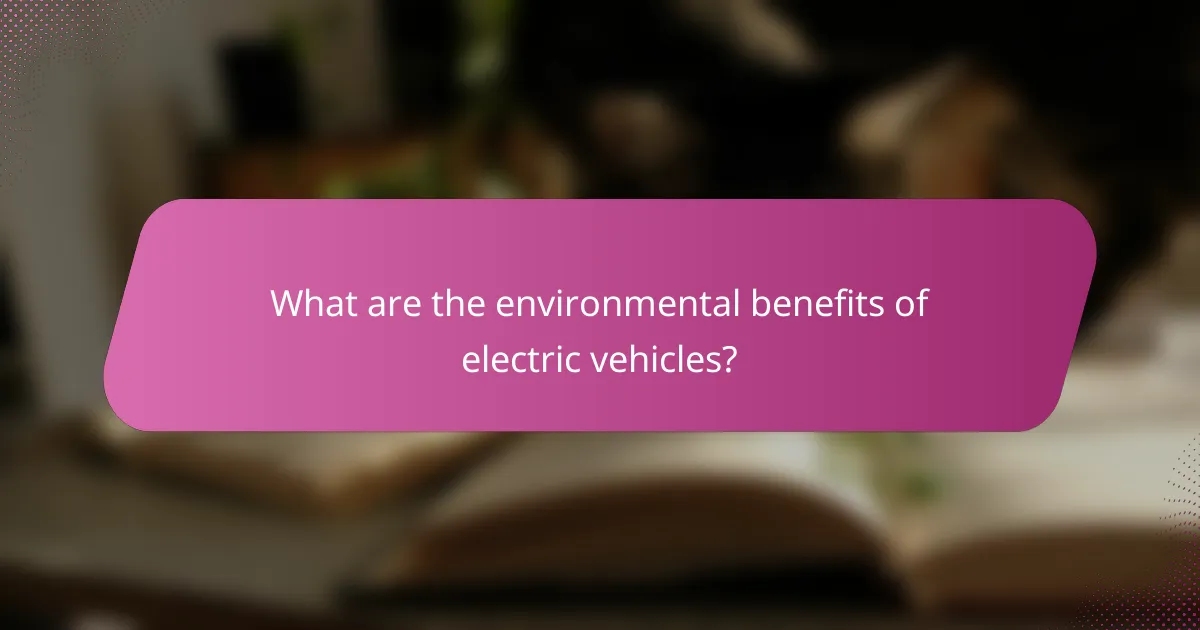
What are the environmental benefits of electric vehicles?
Electric vehicles (EVs) offer significant environmental benefits by reducing harmful emissions and promoting cleaner energy sources. Their operation contributes to lower levels of air pollution and mitigates the impacts of climate change compared to traditional fossil fuel vehicles.
Reduction in air pollution
Electric vehicles produce zero tailpipe emissions, which significantly reduces air pollutants such as nitrogen oxides and particulate matter. This is particularly beneficial in urban areas where vehicle emissions contribute heavily to smog and respiratory issues.
Moreover, as the electricity grid becomes greener with more renewable energy sources, the overall emissions associated with EV charging decrease. For instance, regions that rely on wind or solar power can see even greater reductions in air pollution from EVs.
Impact on climate change
EVs help combat climate change by lowering greenhouse gas emissions. While the production of electric vehicles can generate emissions, studies show that over their lifetime, EVs typically produce fewer emissions than gasoline or diesel vehicles, especially as the energy mix shifts towards renewables.
In many countries, transitioning to electric vehicles aligns with national climate goals, such as reducing carbon footprints by a certain percentage by a target year. For example, the European Union aims to cut emissions by at least 55% by 2030, making EV adoption a crucial part of this strategy.

What are the costs associated with electric vehicles?
The costs associated with electric vehicles (EVs) include the initial purchase price and long-term savings on fuel. Understanding these costs can help consumers make informed decisions about transitioning to electric mobility.
Initial purchase price
The initial purchase price of electric vehicles tends to be higher than that of traditional gasoline-powered cars. Prices for new EVs can range from low tens of thousands to over a hundred thousand USD, depending on the model and features.
However, various incentives, such as federal tax credits and state rebates, can significantly reduce the effective cost. These incentives can range from a few thousand to several thousand USD, making EVs more financially accessible.
Long-term savings on fuel
Long-term savings on fuel are a major advantage of electric vehicles. EVs typically cost less to operate per mile compared to gasoline vehicles, with electricity prices often being significantly lower than gasoline prices.
For example, charging an EV can cost around 3 to 5 USD for a full charge, providing a range of approximately 200 to 300 miles. In contrast, fueling a gasoline vehicle for the same distance could cost double or more, depending on current fuel prices.

What incentives are available for electric vehicle buyers?
Electric vehicle buyers can access various incentives that significantly reduce the overall cost of purchasing an EV. These incentives often include federal tax credits, state rebates, and local programs designed to promote electric vehicle adoption.
Tax credits and rebates
In the United States, federal tax credits for electric vehicles can range from $2,500 to $7,500, depending on the vehicle’s battery capacity and the manufacturer’s sales volume. Buyers should check the current eligibility criteria, as these credits can change based on legislation and vehicle specifications.
Additionally, some states offer their own tax rebates that can further reduce the purchase price. For example, California provides rebates of up to $2,000 for eligible electric vehicles, while New York offers up to $2,000 as well. It’s essential to research both federal and state options to maximize savings.
State and local incentives
Many states and local governments have implemented incentives to encourage electric vehicle use, such as reduced registration fees, access to carpool lanes, and discounts on charging station installation. These benefits can vary widely, so prospective buyers should consult their local government websites for specific offerings.
Some regions also provide grants or low-interest loans for purchasing electric vehicles or installing home charging stations. For instance, programs in cities like Denver and Seattle may offer financial assistance to help offset the costs associated with EV ownership. Understanding these local incentives can enhance the overall value of investing in an electric vehicle.

How do charging infrastructures impact electric vehicle adoption?
Charging infrastructures significantly influence electric vehicle (EV) adoption by determining the convenience and accessibility of charging options for users. A well-developed network of charging stations can alleviate range anxiety and encourage more consumers to switch to electric vehicles.
Availability of charging stations
The availability of charging stations directly affects how easily EV owners can recharge their vehicles. Areas with a high density of charging points, especially in urban settings, tend to see greater EV adoption. For instance, cities with hundreds of charging stations can support a larger number of electric vehicles compared to regions with only a few.
To enhance EV adoption, local governments and private companies are increasingly investing in expanding charging networks. This includes placing charging stations in strategic locations such as shopping centers, workplaces, and residential areas, making it more convenient for users to charge their vehicles.
Fast charging technology
Fast charging technology plays a crucial role in reducing the time it takes to recharge an electric vehicle, making EVs more appealing to consumers. With fast chargers, drivers can typically recharge their vehicles to about 80% in 30 minutes or less, compared to several hours with standard chargers.
As fast charging stations become more prevalent, they can significantly improve the practicality of owning an electric vehicle, especially for long-distance travel. Consumers should look for charging stations that offer fast charging capabilities to minimize downtime and enhance their overall driving experience.

What are the future trends in electric vehicle technology?
Future trends in electric vehicle (EV) technology focus on enhancing battery efficiency, expanding charging infrastructure, and integrating smart technologies. These advancements aim to improve the overall performance, convenience, and sustainability of electric vehicles.
Battery Technology Innovations
Innovations in battery technology are crucial for the future of electric vehicles. Solid-state batteries, for example, promise higher energy density and faster charging times compared to traditional lithium-ion batteries. This could lead to EVs with longer ranges and shorter downtime.
Additionally, research into recycling and second-life applications for batteries is gaining traction. This not only addresses environmental concerns but also reduces costs associated with raw material extraction.
Charging Infrastructure Expansion
The expansion of charging infrastructure is essential to support the growing number of electric vehicles on the road. Governments and private companies are investing in fast-charging stations, which can recharge an EV in under an hour. This makes long-distance travel more feasible for EV owners.
Moreover, the integration of charging stations into urban planning, such as parking lots and shopping centers, will increase accessibility. Incentives for home charging installations are also becoming more common, encouraging EV adoption.
Smart Technology Integration
Smart technology integration is transforming how electric vehicles operate and interact with users. Features like vehicle-to-grid technology allow EVs to supply energy back to the grid, enhancing energy efficiency and stability. This can also provide financial benefits to EV owners through energy credits.
Furthermore, advancements in autonomous driving technology are expected to complement electric vehicles, making them safer and more efficient. As these technologies converge, they will likely redefine transportation and urban mobility.
